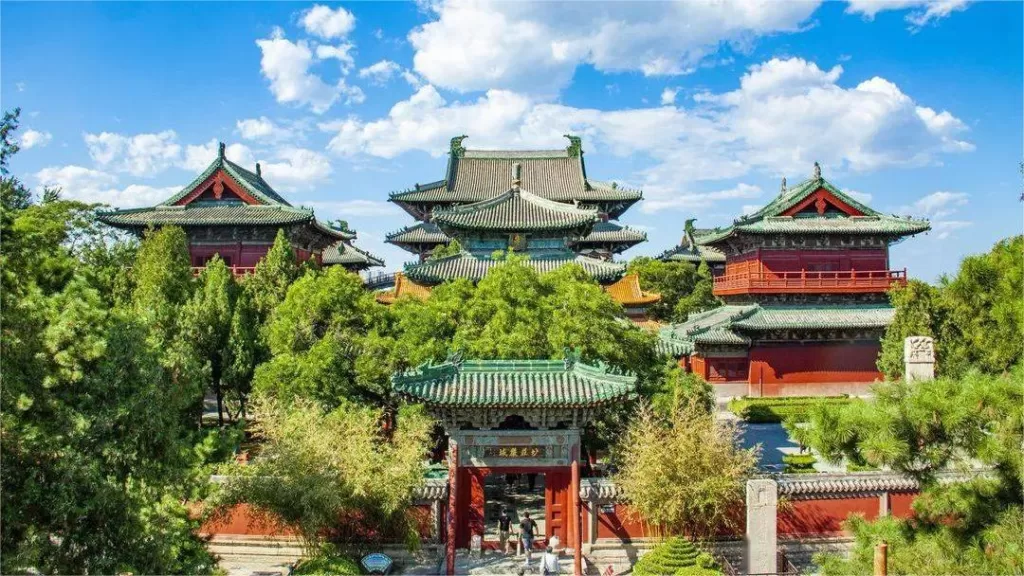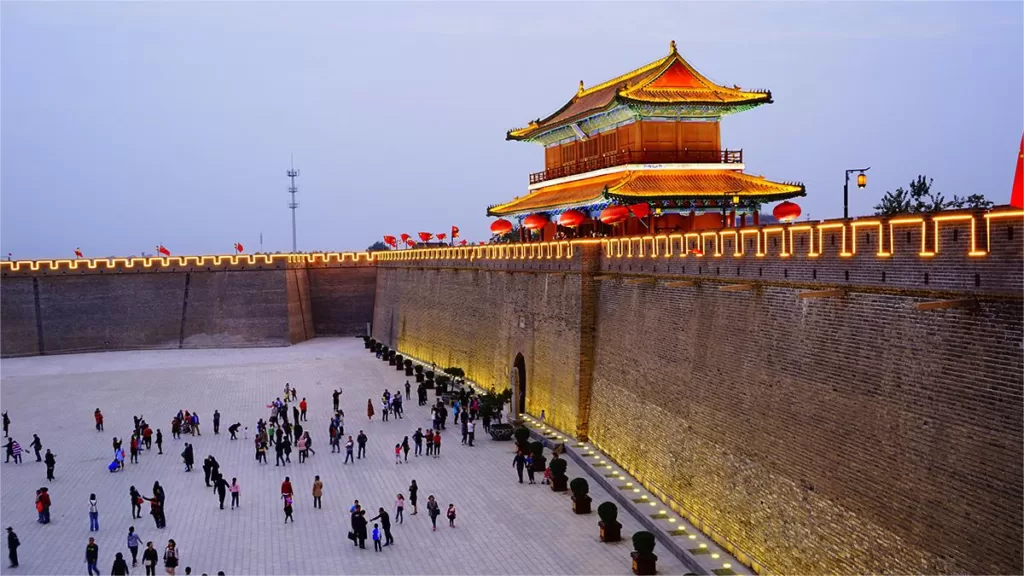Longxing-Tempel, Zhengding - Ticketpreise, Öffnungszeiten, Lage und Highlights


Longxing Temple (隆兴寺), originally named Longcang Temple, was established in the sixth year of the Sui Dynasty’s Kaihuang era (586 AD). In the forty-ninth year of the Kangxi era (1710), it was bestowed the name “Longxing Temple,” a title that has endured to the present day. This temple stands as one of the oldest, largest, and most well-preserved monastic complexes in China, with a history that spans over 1400 years.
While Longxing Temple may not boast widespread fame today, it held immense historical significance, particularly in the eyes of the imperial court. The temple houses a Buddha statue commissioned by Emperor Taizu of the Song Dynasty, Zhao Kuangyin. Additionally, it bears the footprints and inscriptions of successive emperors from the Qing Dynasty, further elevating its status. Many pilgrims visit Longxing Temple to pay their respects and seek blessings.
The expansive temple complex covers an area approximately 600 meters in length and 200 meters in width. Its layout follows a central axis symmetry, featuring key structures such as the Hall of Heavenly Kings, Mani Hall, Ordination Altar, Hall of Great Compassion, Hall of Amitabha, Hall of Maitreya, and the Dragon Soaring Garden. Visitors can traverse the temple grounds, exploring the various halls and appreciating the precious artifacts and treasures on display.
Inhaltsübersicht
- Grundlegende Informationen
- Standort und Transport
- Highlights of Longxing Temple
- Video about Longxing Temple
- Nützliche Tipps aus Rezensionen zusammengefasst
- Andere Attraktionen im Kreis Zhengding
Grundlegende Informationen
| Geschätzte Dauer der Tour | 2 - 3 Stunden |
| Ticketpreis | 50 RMB |
| Die Öffnungszeiten | 8.30 -17.30 |
| Telefon Nummer | 0086-0311-88789987 |
Standort und Transport
Longxing Temple is nestled in the picturesque town of Zhengding (正定), which lies in the Hebei Province of northern China. Zhengding, historically known as Ching-te-chen, boasts a rich cultural heritage dating back to ancient times. The town’s proximity (30 kilometers) to the bustling city of Shijiazhuang adds to its accessibility and charm.
To get there, tourists from other cities can first take a high-speed train to Shijiazhuang and then transfer to Bus No. 1 or a coach to Zhengding County. Alternatively, you can also take a taxi to cover the distance, which takes about 40 minutes and costs approximately 70 RMB.
Highlights of Longxing Temple
Jietan (Ordination Altar)

The Jietan at Longxing Temple is a pavilion-style structure, with the existing wooden parts being reconstructed during the Qing Dynasty. Inside the altar, there are two back-to-back bronze Buddha statues from the Ming Dynasty. One faces south, representing Amitabha, the Buddha of the Western Pure Land, and the other faces north, representing Bhaisajyaguru, the Medicine Buddha of the Eastern Pure Land. This altar is a sacred site where Buddhist monks receive their ordination during religious ceremonies.
In ancient times, only large and significant temples were authorized to have an ordination altar. Since the Song Dynasty, Longxing Temple has undergone several imperial-sponsored renovations and expansions, particularly during the Song, Yuan, Ming, and Qing dynasties. This continuous imperial patronage elevated its status, making it one of the most prominent Buddhist temples in northern China and justifying its right to house an ordination altar.
Longxing Temple’s Jietan is one of the three major ordination altars in northern China, with the other two located at Jietai Temple in Peking and Qingliang Temple on Mount Wutai.
Great Compassion Pavilion and Guanyin Statue

The Great Compassion Pavilion (Dabeige) is the principal building of Longxing Temple, situated towards the rear of the central axis. The pavilion stands 33 meters high, spans seven bays in width and five bays in depth, and features a five-tiered, three-story structure with multiple eaves. Historically, it was known as the “Buddha Fragrance Pavilion” and the “Heavenly Tranquil Guanyin Pavilion.” Records suggest that the pavilion was initially constructed between 968 and 976 AD.
Inside the Great Compassion Pavilion, a towering bronze statue of the Bodhisattva Guanyin, known as the “Great Compassion Bodhisattva,” stands 19.2 meters tall on a 2.2-meter-high stone pedestal. This statue is the tallest and best-preserved bronze Guanyin statue in China, commissioned by Emperor Taizu of Song, Zhao Kuangyin. The statue is often referred to as the “Thousand-Armed, Thousand-Eyed Guanyin” due to its 42 arms, each holding various symbolic items like the sun, moon, a purification bottle, a pagoda, a vajra, and a sword. Unfortunately, 40 pairs of the original bronze arms were destroyed and have been replaced with wooden ones, with only the two arms in front of the chest remaining from the original casting.
The statue is noted for its serene expression, harmonious proportions, and the intricate detailing of the flowing robes, exemplifying the exquisite artistry of the Song Dynasty. The craftsmanship reflects the sophisticated aesthetic and religious devotion of the era, making it a masterpiece of Chinese Buddhist sculpture.
Two-Dragon Screen Wall

Facing the southern side of the Hall of Heavenly Kings in Longxing Temple is the magnificent Double Dragon Screen Wall. This impressive structure measures 22.9 meters in length, 6.8 meters in height, and 1.2 meters in thickness. The wall is adorned with green glazed tiles along its top and sides, and is decorated with motifs of birds and beasts on the ridges and edges.
At the heart of the screen wall, both front and back, is a large lozenge-shaped design featuring two dragons playing with a pearl. This intricate green glazed relief stands out against the vibrant red background, bringing the dragons to life in a vivid display.
Legend has it that these dragons were once iron chains used to bridge the fast-flowing Hutuo River south of Zhengding city, aiding travelers in crossing the waters. Over time, the chains transformed into green dragons that caused trouble for the locals until they were captured by the Daoist priest Zhang Tianshi. General Yuchi Jingde, overseeing the construction of the Grand Buddha Temple, incorporated the dragons into the wall to prevent further harm and to conceal the absence of a mountain gate.
Moni Hall and Ancient Murals

Moni Hall is one of the primary structures of Longxing Temple, situated towards the front part of the central axis. Constructed in 1052 during the reign of Emperor Renzong of the Song Dynasty, the hall spans a total area of 1,400 square meters. The architectural style is a beam-lifted wooden structure with a cruciform floor plan. The name “Moni,” derived from Sanskrit, means “jewel” or “treasure.” According to Buddhist scriptures, “the Moni pearl, when thrown into muddy water, purifies it.” Thus, the hall symbolizes the purification and attainment of tranquility by removing impurities.
The hall’s east and west sides, along with its surroundings, are adorned with murals. While the “Twelve Bodhisattvas of Perfect Enlightenment” and “Eight Great Bodhisattvas” on the east and west walls of the inner chamber are from the Qing Dynasty, the remaining murals date back to the Chenghua era of the Ming Dynasty. The four porticoes depict the “Twenty-Four Heavenly Kings” of Buddhism. The murals on the interior walls are arranged in a “framed and panoramic” layout, illustrating the life of Shakyamuni Buddha from birth, renunciation, ascetic practices, enlightenment, to nirvana. The east and west walls of the inner chamber portray “Western Paradise” and “Eastern Pure Land of Lapis Lazuli World,” each mural measuring 9.36 meters in length and 7 meters in height, showcasing grand compositions.
Alte Bäume

The ancient trees surrounding Longxing Temple stand as venerable witnesses to centuries of spiritual devotion and cultural evolution. These majestic arboreal sentinels, their gnarled branches reaching towards the heavens, create a serene canopy that shelters the temple’s sacred grounds. With roots entrenched in history, these trees echo the footsteps of pilgrims and scholars who sought wisdom and solace beneath their branches. Their enduring presence offers a tangible link to the past, fostering a deep connection between nature and the spiritual aspirations of generations. Amidst the tranquil beauty they provide, these ancient trees are living guardians of Longxing Temple’s profound legacy.
Beauty of the Orient

A striking feature within Moni Hall in Longxing Temple is the Northern Wall’s suspended mountain sculpture from the Song Dynasty, which houses over 30 Buddha statues. The most captivating of these is the vividly colored seated figure of Avalokiteshvara, known as the “Reclining Avalokiteshvara.” This statue, standing at 3.4 meters high, depicts Avalokiteshvara with the left foot resting on a lotus and the right leg raised, both hands embracing the knee, and the body slightly leaning forward. The serene and elegant demeanor, coupled with a slight tilt of the head, exudes tranquility. The deep, wise eyes of the statue appear to gaze downwards, creating an emotional connection with the devotees looking up. This humanized portrayal of the deity was hailed by the renowned writer Lu Xun as the “Beauty of the Orient.”
Video about Longxing Temple
Nützliche Tipps aus Rezensionen zusammengefasst
Local Transportation: It’s not recommended to drive within the ancient city of Zhengding. The attractions are close to each other, making walking or taking a taxi convenient.
Must-See Murals: When visiting Longxing Temple, don’t miss the exquisite murals on the rock walls. Despite their age, they are artistically remarkable.
Culinary Delights Nearby: Explore the local cuisine around Longxing Temple, such as Shijiazhuang roast duck, pot-roasted cakes, stone cakes, tofu pudding, and more. These are highly recommended and worth trying.
Convenient Stopover from Shijiazhuang Zhengding Airport: If you have a layover at Shijiazhuang Zhengding Airport, taking a taxi to Longxing Temple for a historical and cultural experience is feasible. The distance is around 30km, and the one-way taxi fare is approximately 35 yuan, plus a highway toll of 4 yuan.
Interaction with Pigeons: Inside the temple, there are many pigeons. Visitors are encouraged to bring their own food to feed the pigeons.
Andere Attraktionen im Kreis Zhengding

Linji-Tempel, Zhengding

Rongguofu (Rongguo-Villa), Zhengding

Die Hua-Pagode des Guanghui-Tempels

Stadtmauer von Zhengding

Kaiyuan-Tempel, Zhengding
Historische Stätten in Hebei, Shijiazhuang Sehenswürdigkeiten